The Galapagos Islands have long been a highlight of my Bucket List. It first earned a spot in 2003 when I took ‘History of Evolution,’ a required class for the Honors Progam at my college. Reading about Charles Darwin’s explorations and discoveries around the Galapagos wasn’t enough — I wanted see it all with my own eyes.
Cut to 2009. I’ve just signed up for a July trip to Peru with G Adventures (formerly Gap Adventures) when I receive an email offering 50% off any Galapagos trip booked by the end of the year. I decide it must be fate, and I book a return trip to South America for November.
My trip begins and ends in Quito, the capital of Ecuador. Our group will fly to Santa Cruz Island to start a ten-day yacht journey. After the tour officially concludes, I will spend three more days by myself on Isabela Island (the largest of the 16 islands that comprise the Galapagos). Then I’ll fly back to Quito for three more days of exploring and finally return to the United States the day before Thanksgiving.
This is the first day of my Galapagos adventure. I’ve split everything into bite-size chunks to cover my whole two weeks in Ecuador. Enjoy!
Galapagos flashback to November 2009
Let me begin by saying that the beloved East Coast coffee chain Dunkin Donuts is not currently available in the great state of California, save for the Camp Pendleton location, which is 90 minutes from Los Angeles by car. (THIS JUST IN — D&D will open California locations in 2015! Hallelujah!) But I am repeatedly dumbfounded when I travel abroad and encounter Dunkin Donuts in the most far-flung destinations. I took the photo below in the Panama airport (on a layover from JFK en route to Quito). I’ve also seen them in the Miraflores district of Lima, Peru, and even one in the Bangkok train station.

But I digress. Back to the travel business.
Here’s a photo of the flight into Quito.

And from my hotel room window.

Our group stays at the Rio Amazonas Hotel in the La Mariscal district (tourist-friendly). That night I wander around the neighborhood to grab dinner at Mama Clorinda, a local Ecuadorian joint. The power’s off in the neighborhood because the city is rationing electricity (the hotel has its own power supply and is not affected). But it’s eery to walk down streets, which are full of people and open businesses, in near total darkness. I dine by candlelight before retreating to my hotel room for the evening.
That night I flip through the television channels and stumble upon the 1999 movie Double Jeopardy, starring Ashley Judd. Imagine my surprise when Michelle Stafford, an actress from the soap opera I work on, pops up on screen!

I get a kick out of that. (Remember last Thanksgiving in Denver when I randomly saw another actor from my show on TV, in a 1984 episode of The Cosby Show?)
The next morning we leave our hotel bright and early to fly to Baltra airport in the Galapagos (after a brief layover in the coast city of Guayaquil, where most planes stop en route to Baltra). The islands are about 600 miles west of mainland Ecuador.
The Ecuadorian government takes great care to preserve the Galapagos ecosystem. Organic matter is not permitted into or out of the islands. See those blue pads below? They are soaked in a cleaning solution which wipes off the bottom of shoes as people disembark from the plane so that no one unintentionally tracks organic matter over from the mainland.

We take a short ferry from Baltra to Santa Cruz Island.


This is the group I am traveling with! I can’t remember the exact breakdown now, but that’s Andre in the grey shirt on the left (I think he was from Germany). Then to his right is Agnes from Hong Kong in the light blue shirt. Then Michelle, an American living in Germany. Then Rob, an Australian. And Sarah from New Zealand is in the pink tank on the right.

We take a bus all the way across Santa Cruz island to the main city of Puerto Ayora.
Perhaps this map will explain the layout of the islands better… also, note how close we are to the Equator:
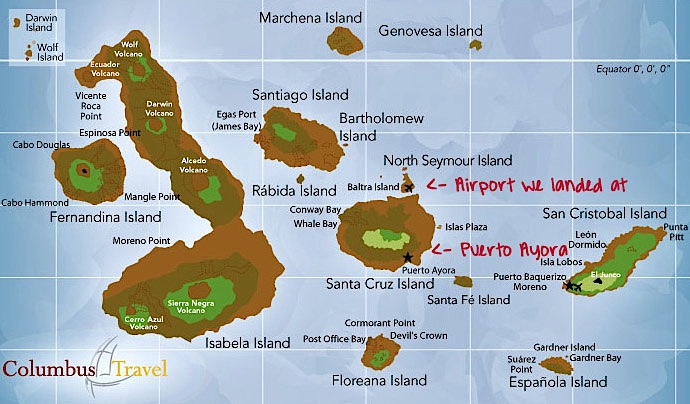
[original map source]
This is what the Puerto Ayora harbor looks like. That color!

G Adventures staff brings us to our new home for the next ten days. I can live with this.

A quick note about getting around the Galapagos:
The Galapagos islands are heavily protected by the National Park. Visitors are only allowed to set foot on most of the islands while in the company of a licensed guide, and only in 2-4 hour shifts. Tourists are allowed to travel by themselves on certain islands with local populations like Santa Cruz, Isabela Island, and San Cristobal. But anyone who wants to visit the other protected islands like Floreana, Espanola, Santa Fe, and Rabida can only do so with a guide. Since there are no accommodations on these islands, the only way to visit them is by boat. Therefore the most common way to experience the Galapagos is via a water-based tour (i.e. on yachts or small cruise ships), although land-based travel is an option on the aforementioned populated islands.
Back to our yacht. I hang out on the back deck as these little dudes come up to greet me.

We settle into our rooms (I luck out and score a single room, due to the odd number of females on board) and then shuttle back to Puerto Ayora for a jeep tour of the Santa Cruz highlands.
Not everyone on the boat is on the same schedule. Most people are only on board for half the trip, and I’m actually the only one staying the full ten days, so halfway through the trip everyone else leaves and new people will come on board. This means that on two occasions I have a different itinerary than the others. So I embark on this tour of the highlands solo, along with one of our leaders, Eduardo.

We visit El Rancho Primicias, home to many Galapagos giant tortoises. Here Eduardo shows off a shell in the visitor’s center.

We wander through several fields, taking care to respect the tortoises’ space while snapping our photographs. For the most part they ignore us and continue chomping on the grass.



These giant tortoises can live over 100 years in the wild and up to 170 years (!) in captivity. The males often weigh over 800 lbs.
Throughout the 1800s these animals were hunted and almost became extinct, but efforts to stabilize their population over the last few decades have made a difference.



I love this shot of a mama and baby tortoise.

After saying good-bye to the tortoises, we visit a nearby lava tube.


I’ll turn to Wikipedia for a more scientific definition than I could muster up:
Lava tubes are formed when an active low-viscosity volcanic lava flow develops a continuous and hard crust, which thickens and forms a roof above the still-flowing lava stream. They can be actively draining lava from a volcanic source, or they can be extinct, meaning the lava flow has ceased and the rock has cooled and left a long cave-like channel. [via]
Our tour guide explains it in layman’s terms: lava tubes are like brownies that are almost done baking, and the top has hardened but the chocolate underneath is still gooey.
I heartily approve of baking analogies.


That evening we all reunites onboard for our welcome party with the boat crew. Cheers!
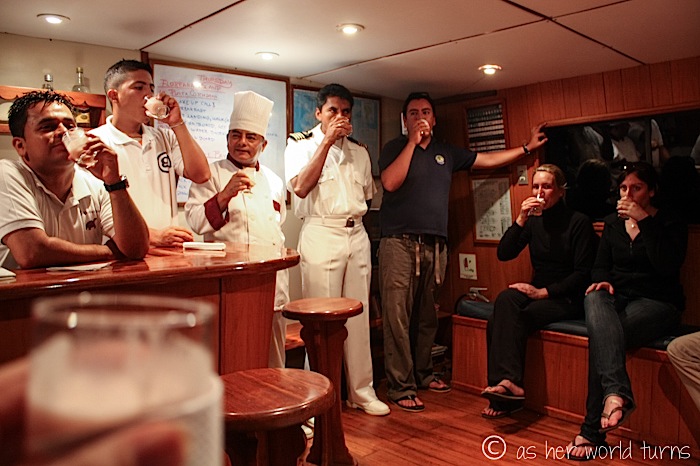
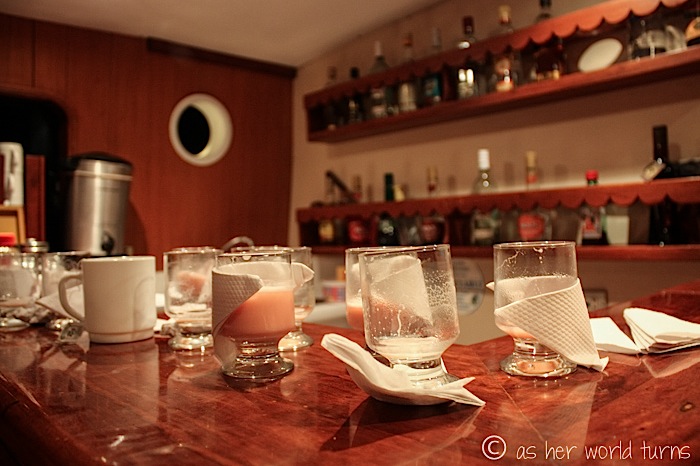
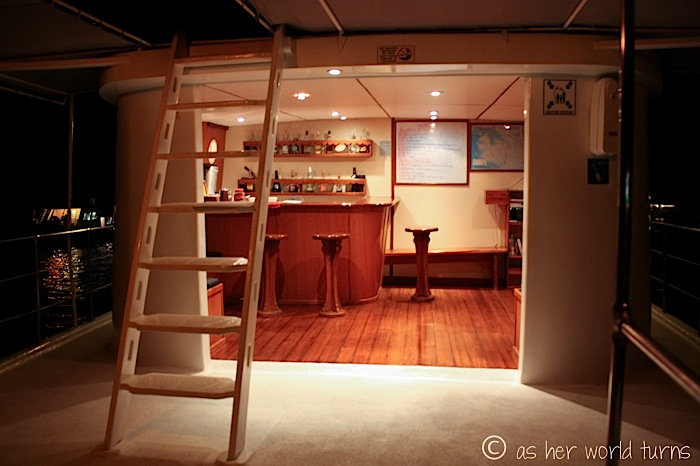
We have the option of going back to Puerto Ayora for a few hours in the evening. I venture back with Rob and Sarah to explore the town and, of course, take photos.
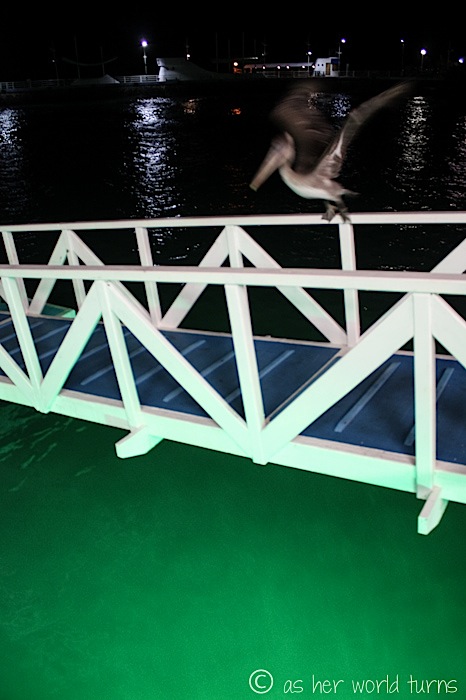





After we climb back on board, the boat takes off for Floreana Island. More on that tomorrow.
And thus concludes my first two days in Ecuador!

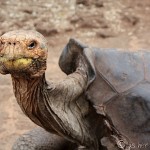
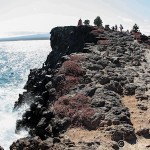
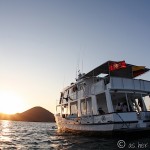
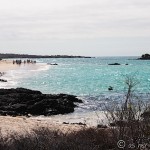
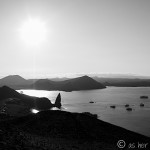

What a great blog, Erica! I can’t wait to read more!
Thank you so much Erika!! I’m so excited to share more!